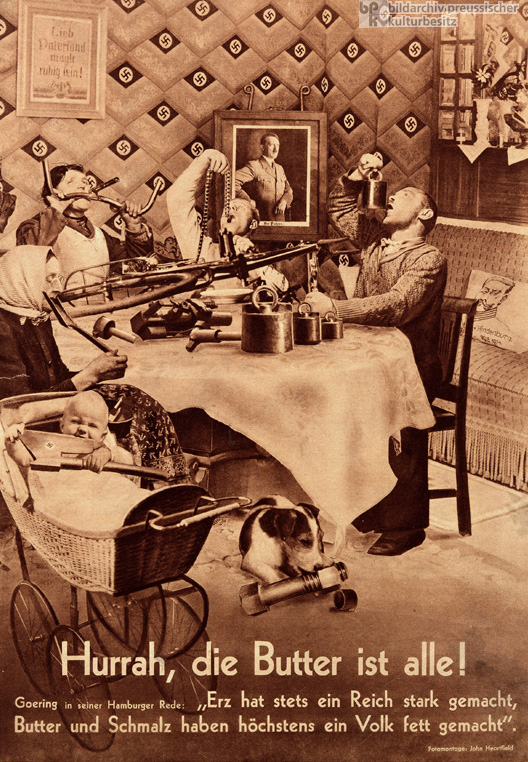The Weimar Republic
(SPD Poster, 1920)
The Weimar
Republic is the term applied to the period from 1918-1933 in Germany. The
parliamentary system of Weimar, similar to that of Britain, was the first true
democracy in Germany and the ruling party — the Social Democratic Party, a center-left party — sought to unite the masses for democratic means. Despite their goals of
unity, loyalty, and duty, the Social Democratic Party inherited complex and
dire circumstances, which, along with their unpopular actions and efforts to mend the broken country,
made the SPD an easy target for both the more Leftist (Socialism, Communism)
and the Right (Nationalism, Authoritarianism) parties. These issues include:
• Extreme
terms of the Versailles Treaty (Occupation of Rhineland, limitations on German armed and naval forces, prohibition
of weapons, loss of colonies and European
territories, reparation of 226 billion Marks)
• German
Revolution (November 1918-January 1919)
•
Industrialization/modernization
• Economic
crisis (hyperinflation, severe drop in living standard, Great Depression)
• Frequent
political changes (splitting parties uprising and challenging the SPD)
•
Social-cultural changes (national healthcare, mobilization of workers, veteran disability program, etc.)
• Public
disappointment with Capitalism
By the time the SPD controlled the government in 1918, there
were multiple individual parties on both the Right and Left. While every party
recognized the crises facing the Weimar Republic and the German people, each
one had its own solution incongruous with the others.
The Right
The
political right (including the DVNP) propagated the Stab-in-the-Back Myth to fight against the center-left Weimar
Republic and SPD. The Right parties argued that Germany’s first military defeat
(WWI) came at the hands of the socialists and their 1918 revolution, thus, the
crippled status of Germany was directly caused by the ideology of the left.
Because of this, the Right groups cited, all leftist politics, economics, and
even art, was unacceptable and abominable.
The Left
(USPD Poster 1919)
Though the SPD was a leftist party, groups unhappy with the
SPD’s class collaboration and support of WWI split from the party in 1917 to
for new and more extreme left groups (primarily, the USPD and KPD). These
groups, though varying in liberalism from democracy to Marxism, all opposed
the government's handling of WWI (counter groups began to form within the SPD prior to 1917 for this reason), supported the working class (proletariat) and felt further alienated by
their parent party when the SPD used the right-wing paramilitary forces to
suppress any revolutionary uprisings.
The Left: Art
Artists
from various schools (Dada, Expressionism, Neue Sachlichkeit) sided with the left
groups and used their art as public outcry and commentary against the state of
German society and government. Though many artists within the Bauhaus were left-leaning, its founder Walter Gropius declared it apolitical. It is not included here because its pieces were not created as social/political commentary or criticism.
 |
Cut with the Kitchen Knife...
Dada |
• Dada: A group protesting the
bourgeois, nationalism, rationality, and all other institutions and beliefs
developed from the Enlightenment as the cause for the horror and depravity of
modern humanity. Because of this rejection of the traditional and rational, the
Dadaists were opposed to the figuration of its contemporary — Expressionism

• Expressionism: With the
reprehensible results of WWI, both economically and in lives lost,
Expressionists moved from a search for an inward, spiritual enlightenment to an
anational socialism, criticizing the bourgeoisie, capitalism and democratic
means while lauding the resurgence of a “spiritual attitude […] which has
existed for millennia in the history of humanity.” This spiritual attitude is
the Expressionists response and solution to the Dadaists view of the
Enlightenment and also explains why, unlike the Dadaists, the Expressionists
did not reject traditional forms such as the figure.
• Neue Sachlichkeit (New Objectivity): see
Socialism and Dystopia: Neue Sachlichkeit
Images Used
(I was having formatting issues when adding captions)
1. SPD political poster
2. USPD political poster
3. Dawn From in the Shadows, George Grosz, 1920-21
4. Prague Street, Otto Dix, 1920
5. The Orator, Magnus Zeller, c1920
6. Cut With the Kitchen Knife..., Hannah Höch, 1919-20
7. The Widow II, Kathe Kollwitz, 1922
Works Cited
Berger, Stephen. "Germany." The International
Encyclopedia of Revolution and Protest: 1500 to the Present. Guntram H.
Herb and David H. Kaplan ed. Vol. 2: 1880-1945. Santa Barbara, CA: ABC-Clio,
2008. 609-22. Gale Virtual Reference Library. Web. 22 Nov. 2012.
Lewer, Debbie. "Revolution and the Weimar Avant-Garde:
Contesting the Politics of Art, 1919-1924."Weimar Culture Revisited.
New Yok: Palgrave Macmillan, 2011. 1-21. Print.
Peters, Olaf. "Aesthetic Solipsism: The Artist and Politics
in Max Beckmann 1927-1938." Totalitarian Art and Modernity.
Aarhus: Aarhus UP, 2010. 325-45. Print.
Schmidt, Ingo. "Communist Party, Germany." The
International Encyclopedia of Revolution and Protest: 1500 to the Present.
Immanuel Ness ed. Vol. 2. Malden, MA: Wiley Blackwell, 2009. 826-29.Gale
Virtual Reference Library. Web. 27 Nov. 2012.
Williams, John A. Foreword. Weimar Culture Revisited.
New Yok: Palgrave Macmillan, 2011. N. pag. Print.
Article by Catherine Estrada














